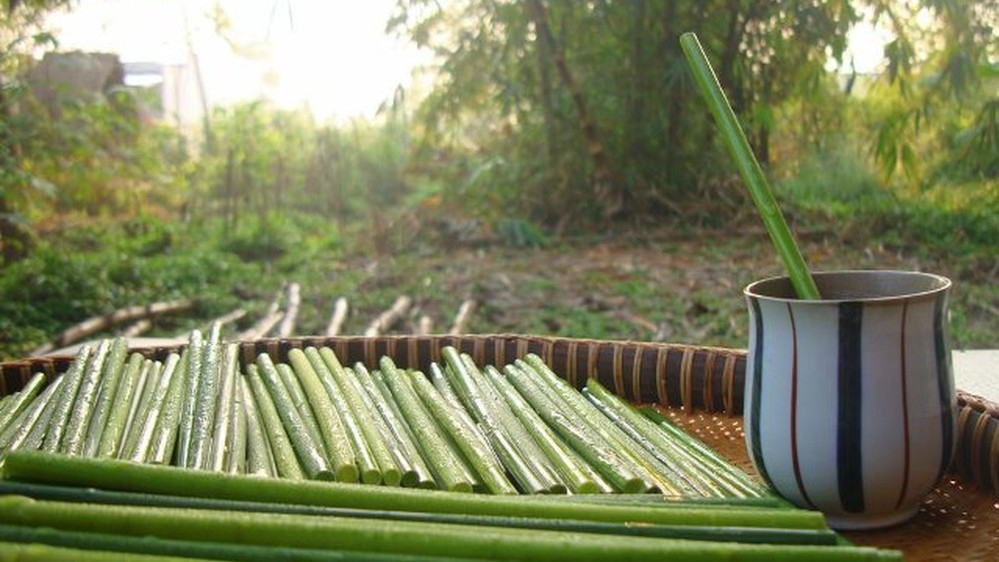In recent years, Vietnam's tourism has grown strongly in terms of both international and domestic visitors, gradually becoming a key economic sector and increasingly contributing to the overall development of the country. However, the increasing amount of littering in many popular tourist destinations, including large quantities of hard-to-decompose waste such as plastic bottles, bags, and packaging, has negatively impacted the environmental protection and public health.

Straws made from eco-friendly materials
According to the Food and Agriculture Organization of the United Nations (FAO), Vietnam emitted more than 1.8 million tonnes of untreated plastic waste in 2018, accounting for nearly 6% of the world's plastic waste. Vietnam also ranks fourth in the world for the amount of plastic waste dumped into the sea. In the World Economic Forum's global ranking of tourism and tourism competitiveness reports, Vietnam's environmental sustainability is underestimated, ranking 129th out of 136 countries.
Recently, at the conference "Tourism without plastic waste" organised by the Quang Nam Tourism Association, many figures startled the audience. On average, Quang Nam creates 660 tons of waste daily, 92 tons in Hoi An alone, of which plastic waste accounts for 18% to 20%.According to a report from the World Wide Fund for Nature (WWF), an average of 155 tonnes of waste is generated every day in Phu Quoc, Kien Giang Province, but only 91 tonnes are collected. The amount of plastic waste collected by people is 10.8 tonnes per day, accounting for only 33.6% of the total plastic waste generated. With green tourism becoming an inevitable trend, tourists are increasingly concerned with environmentaly friendly factors. As such, the overload of plastic waste in many areas and tourist destinations will surely cause these destinations to "lose points".
In fact, recently, aware of the importance of the urgent demand on protecting the environment in tourism activities, some businesses, especially reputable tourism enterprises, have pioneered in finding solutions to limit plastic waste through specific actions. For example, instead of dispensing drinking water with small plastic bottles, they have moved to storing water in large bottles; meeting rooms and hotels have turned to cups and glass bottles for reuse; plastic straws are being replaced with straws made from eco-friendly materials such as rice, bamboo, and stainless steel. Some travel units also develop travel tours to collect rubbish on river branches or during a forest trekking journey. This is a good sign that the people working in the tourism sector have made positive changes in awareness and are growing increasingly aware of environmental protection.
However, it is not enough if just rely on the change of some leading enterprises. Therefore, in order to bring about significant results in restricting plastic waste from tourism activities, a comprehensive and specific strategy is required with the involvement of the State, businesses and people. Currently, some countries in the world stipulate that businesses wishing to do tourism business or joining tourist associations and organizations must set out an action plan and commit to doing business sustainably on the basis of environmental protection. From the good experiences of other countries, Vietnam's tourism management agencies should soon deploy the application of a wide range of criteria for certification of sustainable tourism labels, green tourism, and energy saving for agencies and tourism businesses, aiming to contribute to improving management efficiency, and reduce negative impacts of tourism activities on the environment. The certification also helps affirm the reputation, enhance responsibility, and improve the ability to attract tourists.
Additionally, through the media, it is necessary to call and mobilize people and tourists to join in protecting the environment, limiting plastic waste, and saving electricity and water. It is necessary to have a mechanism to encourage units to research and produce alternative materials. On the tourism business side, priority should be given to products such as straws, mugs, bowls, chopsticks made with materials of organic origin or that can be used repeatedly; to use organic or reusable packaging and cleaning chemicals and utensils made from environmentally friendly materials, with environmental protection labels; and to distribute materials guiding tourists to respect the regulations on environmental protection, limiting plastic waste.